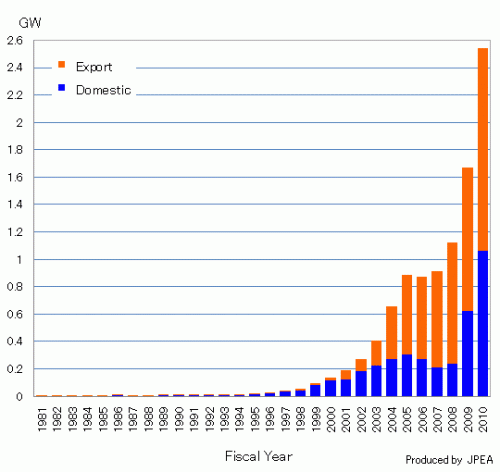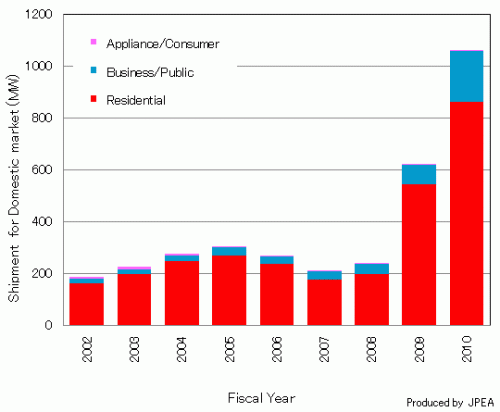Land of the Rising Sun: Japan's Surging Sales of Residential Solar PV

From wind and geothermal power to fuel cells, the Great East Japan Earthquake that occurred March 11 off the coast of Fukushima — along with much longer standing energy security concerns — has revitalized clean and renewable energy prospects in Japan. Smoothing the way forward is the introduction of a national feed-in tariff that’s slated to go into effect on July 1 this year.
Once the world leader in use of solar photovoltaic (PV) energy, solar PV is once again coming on strong in Japan. Domestic sales of solar PV cells rose 30.7% year-over-year in 2011 to 1,296 MW, the first time they’ve exceeded 1 gigawatt (GW), according to the Japan Photovoltaic Energy Association (JPEA), which noted that government incentives for homebuyers installing solar energy systems boosted the total. As can be seen in the following chart, residential solar PV installations far and away account for the largest share of Japan’s solar PV installations.

According to market researchers at the Yano Research Institute, Japan’s domestic market for PV power generation systems is expected to grow to 1,725 billion yen (about US$ 22.4 billion) from fiscal 2011-2020, a 263.2% increase.
Growing worldwide demand for solar energy systems and technology is also helping Japanese manufacturers. Though October-December sales were weak, Japanese solar PV cell exports rose 1.2%, to 1,462 MW for 2011 as a whole, Reuters reported. A chart from JPEA shows total Japan solar PV shipments and destinations from 1981-2010.
FiT Centerpiece of Japan’s Renewable Energy Drive
In addition to its human and environmental costs, the nuclear power disaster at Tokyo Electric Power’s Dai-ichi plant in Fukushima is having dramatic repercussions on Japan’s electricity production and energy security. Only 4% self-sufficient in meeting its energy needs, only three of Japan’s 54 nuclear power plants are now operating, and all of them could be shut down by April should restart approvals be denied. That’s drastically increased Japan’s reliance on fossil fuel imports, the bill for which is increasing $30 billion a year, Reuters notes in its report.
Counting on increased nuclear power capacity to meet more of its domestic energy needs, the Dai-Ichi nuclear disaster prompted an abrupt reversal in national energy policy. Japan’s now moving forward with a broad-based drive to increase use of clean, renewable energy resources, the center piece of which is its national feed-in tariff (FiT).
Officially known as the “Law on Special Measures Concerning Procurement of Renewable Energy Sourced Electricity by Electric Utilities,” Japan’s feed-in tariff (FiT) includes solar PV, wind, small and medium-scale hydropower, geothermal, and biomass.
As explained on the Japan for Sustainability website, the FiT law requires Japanese electric utilities to purchase electricity generated from renewable energy sources at set prices that cover costs plus a margin over a set period of time. Electric utilities will be allowed to levy a surcharge based on customers’ usage to recoup the additional cost. The new FiT law also includes measures intended to avoid regional surcharge imbalances.
FiT surcharges and electricity rates are to be reviewed at least every three years, with surcharges to be reduced 80% or more for energy-intensive industries, such as steel and chemical manufacturing. The Japanese government was also reportedly considering using revenue from taxes on petroleum and coal to reduce and make up for exempted surcharge revenue, according to Japan for Sustainability.
Japan’s FiT and Solar PV
When it comes to solar PV systems, the FiT is aimed at factories and other facilities that generate 10 kW or more of electricity as opposed to smaller units for residences, which will be applied for excess electricity purchasing. The FiT for residential solar PV systems is to be ten years and 15-20 years for other renewable power generation systems.
As Japan for Sustainability points out, “Residential solar panels are now sold at high-volume home-appliance retailers, rapidly boosting the number of households that are installing solar panels on their roof. Both the national and local governments have subsidy programs for PV power generation systems, but some local governments have already exhausted their funds for these programs because residents rapidly snapped up the subsidies.”
You can return to the main Market News page, or press the Back button on your browser.

